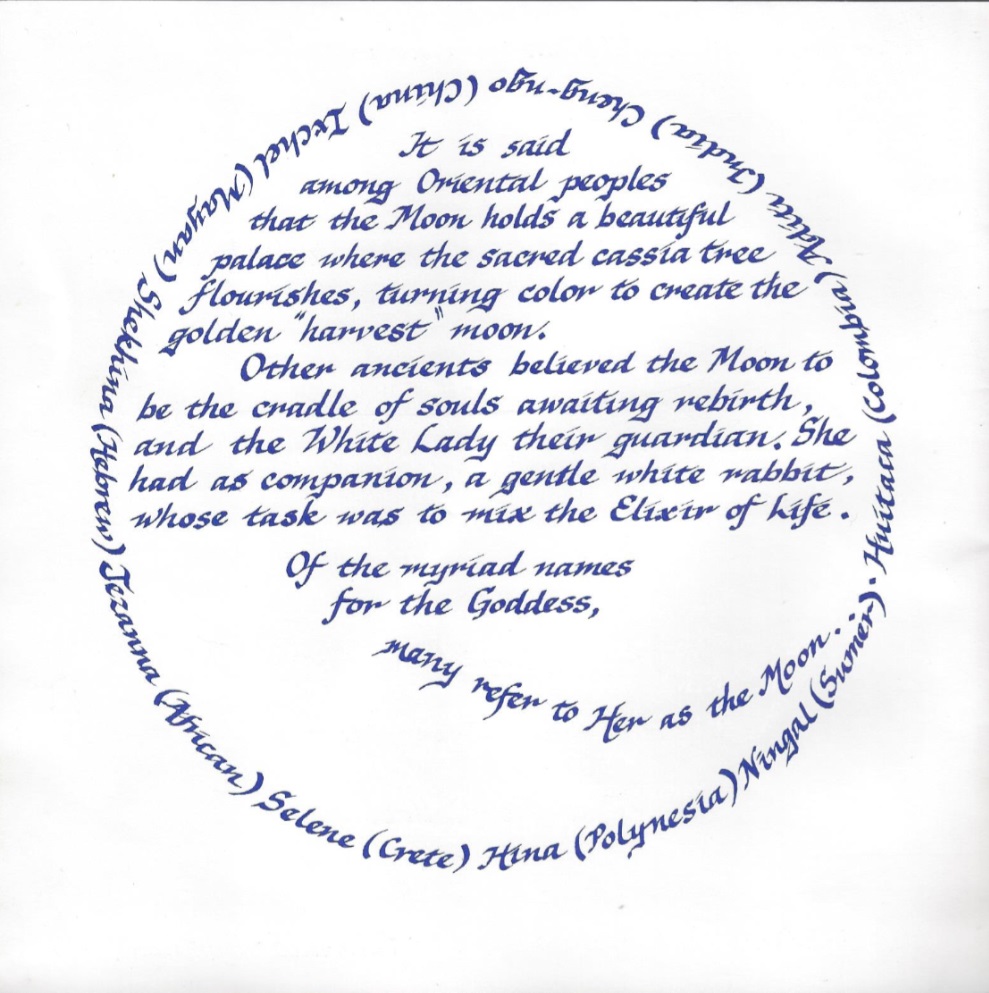
from Daughter of the Lady Moon
Carla C. Gipe and Prairie Jackson, 1980, 1981
In ____(year), the Chinese Mooncake Festival is held on ____(weekday), ______(month), __(date).
According to the Lunar Chinese Calendar, Zhongqiu Jie (Mid-Autumn Festival) or Mooncake Festival is celebrated on the 15th day of the eighth lunar month, around the time of the autumn equinox--when the moon is at its “fullest” -- visually most large and bright.
Sharing mooncakes is one of the traditions of the Mid-Autumn Festival. The Mid-Autumn Festival is held on the 15th day of the 8th month of the lunar calendar with the full moon at night. On the Gregorian calendar, this date is corresponding to a full moon sometime in either late September to early October.
Traditionally, families would take time to sit outside and view the moon.
Mooncakes are often eaten outside under the moon. The crust is often adorned with symbols associated with the Mid-Autumn festival. It’s traditional to pile thirteen mooncakes into a pyramid, symbolizing the thirteen moons of a complete lunar year.
A children's activity for this holiday is making colorful lanterns. Children create them in different shapes to be hung in trees or houses, or floated on rivers. There are also Kongming lanterns which can fly because the burning candles heat the air in the lantern. Children will write good wishes on these lanterns . Families let the Kongming lanterns fly up into the sky carrying wishes to Chang-e.
Mid-Autumn Festival activities include enjoying an elaborate family reunion dinner, which is why it is called the Festival Of Reunion.
After dinner, a family will traditionally put a table outside the door, or in the courtyard. They set out mooncakes, fruit, incense, and candlesticks on the table, facing towards the moon. Fruit for worshiping the moon includes a watermelon, grapefruit, pomegranate, pear, persimmon, grapes, or other seasonal fruit.
It has been common to create an altar and burning incense in honor of Chang'e --the Chinese Moon Goddess of Immortality– and other Taoist deities. Altars honoring Chang’e are set up in the open air, facing the moon. (New lotion, bath salts, make-up and other “beauty aids” are placed on the altar for her to bless. Chang’e endows those who worship her with great beauty.)
Among the decorations purchased for the celebration table is a clay statue of the Jade Rabbit. In Chinese folklore, the Jade Rabbit (who is depicted as white) was an animal that lived on the moon and accompanied Chang'e. Offerings of soy beans and cockscomb flowers were made to the Jade Rabbit The mythological white rabbit makes the elixir of immortality on the Moon.
Yet worshiping the moon is reportedly a fading tradition.
The Chinese have celebrated the harvest during the autumn full moon since the Shang dynasty (c. 1600–1046 BCE) The festival celebrates three fundamental concepts that are closely connected:
Popular Chinese Mid-Autumn Festival Greetings/Sayings
Happy Mid-Autumn Festival!
Zhongqiu kuaile!
Wish you and your family a happy Mid-Autumn Festival!
Zhu ni he ni de jiaren zhongqi kuaile!
A bright moon and stars twinkle and shine. Wishing you a merry Mid-Autumn Festival, bliss, and happiness.
Haoyue shanshuo, x?ngguang shanyao, zhongqiu jiajie, meiman kuaile!
The roundest moon can be seen in the autumn. It is time for reunions. I wish you a happy Mid-Autumn Day and a wonderful life.
I want to make a toast. I Wish that the round moon take my best blessing to you. May you have a happy family and a bright future.
I wish that your career and life, just like the round moon on Mid-Autumn Day, be bright and perfect.
Happy Mid-Autumn Festival! May the round moon bring you a happy family and a successful future. Due to ancient China's cultural influence, Mid-Autumn Festival spread to other parts of Asia.
| Observed by | China, Taiwan, Hong Kong, Korea, Macau Vietnam, Singapore, Malaysia |
|---|---|
| Type | Cultural, Religious |
| Significance | Celebrates the end of the autumn harvest |
| Observances | Consumption of mooncakes Consumption of cassia wine |
| Date | 15th day of the 8th lunar month |
The Mid-Autumn Festival is also known by other names, such as:
So why am I putting this festival on “Yet Another Wicca Site”? I think I first learned of this festival back in 1977. I hadn’t yet found anyone around me practicing Neo-Paganism or Wicca in Maryland where I resided. Still, I read about this holiday and the story of Chang’e. Actually I seem to remember reading an article about the “Harvest Moon Festival,” and “Mooncakes,” and then looking up Chang’e. Yet, I seemed to be able to find the tale quickly so maybe I’d read Chang’s story first and did not know it was attached to a holiday. (Actually I think the first spelling I read of this Chinese Goddess’s name was “Chang-O.” (I was forever reading about different mythologies in high school. I was such a weird kid. )
Yet, when I connected the Goddess and the Festival in my head, I was enchanted, and I began to try to figure out where I could find these Mooncakes for the Harvest Moon Festival. I was unsuccessful for many years. Eventually--of course--Mooncakes have appeared in the USA in Asian grocery stores for purchase. I first found them in the 1980’s by accident at a little Asain store in Oxon Hill. Stunned and hopefully delighted, I asked, “Are these Mooncakes?” The lady behind the counter said, “Oh yes, but they are just for a small holiday.” Wide-eyed, I said “I’ve been looking to find these, “ and hastened buy them and scurry out the door before she could try talk me out of it. I remember it was around my birthday.
[more later]
2017 Myth Woodling
Sources:
Echo Huang,
The reason we eat mooncakes during the Mid-Autumn Festival originates in a folk tale about undying love and betrayal,
October 01, 2017.

from Daughter of the Lady Moon
Carla C. Gipe and Prairie Jackson, 1980, 1981